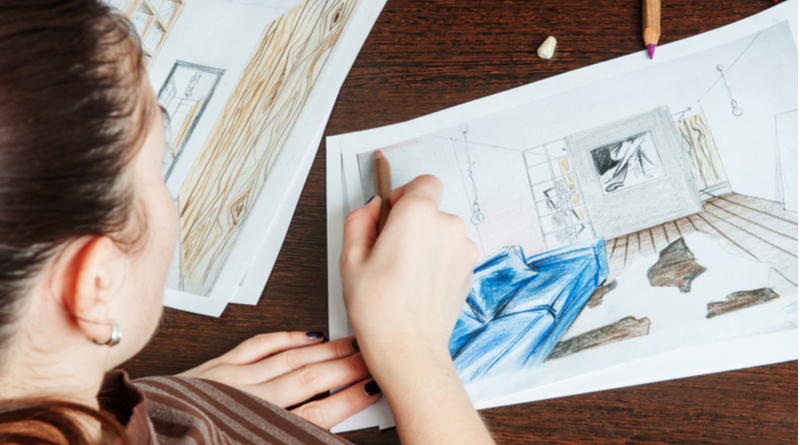What is Interior Design?
Interior Design is the practice of planning and supervising the design of architectural interiors and their furnishings as well as the layout of internal space within a building or structure.
An interior designer works with clients to create aesthetically pleasing rooms and spaces. Interior Designers are skilled in design principles and will create designs that impact positively on the function, wellbeing, and safety of interior spaces.
What courses are available?
Universities and colleges in Ireland are offering Interior Design courses in the following subject areas:
- Diploma in Interior Design – The study of the principles of design and communication techniques allowing work to be presented.
- Interior Design Introduction – The study of the creative skills and applications of Interior Design for personal spaces.
- Interior Design & Decoration Course – The study of interior design and decoration.
- Diploma in Interior Designing – The study of the design of interiors and furnishings, the history of modern interior design, and design principles.
- Interior Architecture – The study of interior architecture and design, space planning, technology, and visualization.
- Advanced Diploma in Interior Designing – The study of interior design, reading and creating drawings, understanding concept inspiration, and style process.
- Colours for Designing – The study of professionally presented colour design solutions.
- Home Decorating & Refurbishment – The study of practical interior design skills and an understanding of how to improve home value.
- Mastering Home Decorating and Gardening – The study of the knowledge and skills necessary to handle home decorating and improving.
Studying Interior Design in college
The study of Interior Design covers fundamental design theory work as well as Interior specific design principles and elements.
Courses will be delivered through lectures, assignments, tutorials, and taught modules. It is common practice within the study of interior design to be taught by practicing architects, designers, buyers, and even art historians which provide not only insight into the career but also valuable industry links.
Courses are also regularly reviewed by industry professionals to ensure that they are following the best practice and current needs of the industry. Assessments will take place continuously with written examinations and practical assignments combined to achieve a qualification.
There are full-time courses that run anywhere from 1 year to 2 years depending on the course and modules selected. There are also part-time courses and night courses available so you can be sure to fit in your studies no matter what your schedule is like.
Interior Design is a very practical hands-on field with field trips locally and internationally and internships for work experience often available. Through work experience and volunteering or part-time work as an apprentice, you will be able to practice your practical understanding of Interior Design. This will help to broaden your skillset and establish professional contacts.
Career options
After completing a course in Interior Design you will be a part of a flourishing industry where interior design and decoration are in more demand than ever before.
Interior designers can be independent contractors who need to build a client base, or can work for an established design firm. In either case, they need to build a positive reputation in the industry to secure future work. Interior Designers are generally hired to design and decorate homes or corporate offices but it is also common for businesses such as Art galleries, Bed & Breakfasts, Boutiques, Hotels, Model Homes, Museum stores, and restaurants to make use of an Interior Designer.
Interior designers need to have flexible work hours and varied work environments. Schedules are often tailored to their client’s needs, and designers often travel to their client’s home or business to discuss plans for the design. After an initial consultation and a few strategizing sessions, designers visit shops to purchase furniture, artwork, and supplies for creating the desired look and function.
Related jobs include:
- Interior and spatial designer
- Exhibition designer
- Production designer in theatre, TV, or film
- Visual merchandiser
- Architect
- Architectural technologist
- Estates manager
- Furniture designer
- Graphic designer
- Product designer
- Stylist
- Textile designer
Further study
After completing a course in Interior Design you may choose to pursue further study in a related field to build skills relevant to another design field, such as product design, graphic design, or surface design. Another option is to train for a profession outside of the design industry, for example, teaching, youth work, or art therapy.
FAQ
What are the typical responsibilities of an Interior Designer?
- Working with clients on their project goals
- Creating project timelines
- Visualizing how spaces can be used
- Estimating project costs
- Sketching design plans
- Sourcing materials and furnishings and placing orders
- Overseeing project construction and installation.
- Coordinating with contractors and services
What is the difference between an interior designer and an interior decorator?
Interior design is the art and science of understanding design principles and people’s behavior to create functional spaces within a building, while interior decorating is the furnishing or adorning of a space with decorative elements to achieve a certain aesthetic. In short, interior designers may decorate, but decorators do not design
Where can I study Interior Design?
Explore your options here
Did You Know?
- There are many articles on the psychology of color, and for good reason – different colors and tones can have a definitive effect on both our emotions and moods. Blue decreases appetite for example, and orange is supposedly the best color for concentration and productivity.
- The most popular style of carpet is twisted pile carpet.
- Whilst most kitchen projects are currently done in a contemporary style, homeowners aged between 25 and 34 are six times more likely to covet an industrial-style kitchen than those aged 54 and over. Those in this younger age bracket prefer industrial features such as exposed brick and recycled wooden elements, which suggests a growing trend that shows no sign of dying out.
- In the U.S state of Alaska, there are only 30 registered interior designers.
- The human mind processes visual information 60,000 times faster than text.












Comments